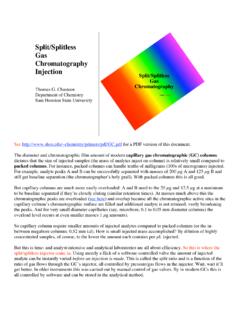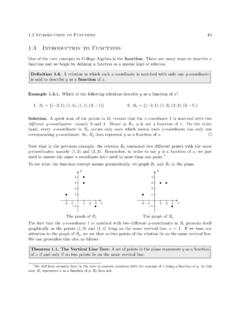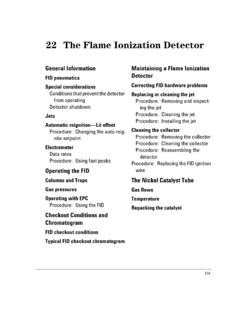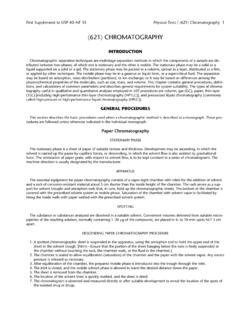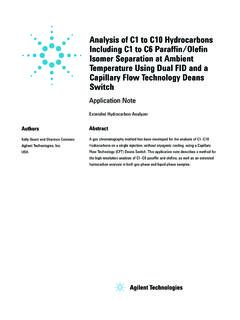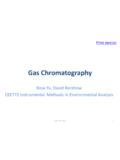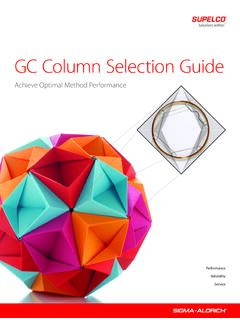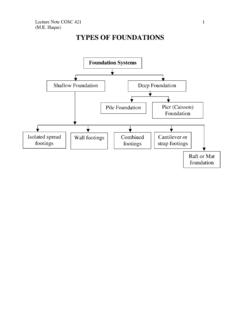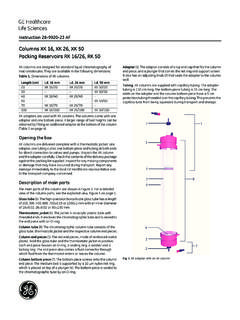Transcription of Split/Splitless Gas Chromatography Injection
1 Split/SplitlessGasChromatographyInjectio nThomas G. ChasteenDepartment of ChemistrySam Houston State UniversitySee ~chemistry/primers/ for a PDF version of this diameter and chromatographic film amount of modern capillary gas chromatographic (GC) columnsdictates that the size of injected samples (the mass of analytes inject on-column) is relatively small compared topacked columns . For instance, packed columns can handle tenths of milligrams (100s of micrograms) example, analyte peaks A and B can be successfully separated with masses of 200 g A and 125 g B andstill get baseline separation (the chromatographer s holy grail). With packed columns this is all capillary columns are much more easily overloaded: A and B need to the 20 g and g at a maximumto be baseline separated if they re closely eluting (similar retention times). At masses much above this thechromatographic peaks are overloaded (see here) and overlap because all the chromatographic active sites in thecapillary column s chromatographic surface are filled and additional analyte is not retained, vastly broadeningthe peaks.
2 And for very small diameter capillaries (say, microbore, to mm diameter columns ) theoverload level occurs at even smaller masses 1 g amounts).So capillary column require smaller amounts of injected analytes compared to packed columns (or the in-between megabore columns : mm ). How is small injected mass accomplished? By dilution of highlyconcentrated samples, of course, to the lower the amount each contains per L this is time- and analyst-intensive and analytical laboratories are all about efficiency. So this is where thesplit/splitless injector come in. Using merely a flick of a software-controlled valve the amount of injectedanalyte can be instantly varied before an Injection is made. This is called the split ratio and is a function of theratio of gas flows through the GC s injector, all controlled by pressure/gas flows in the injector. Wait, wait it llget better. In older instruments this was carried out by manual control of gas valves. By in modern GCs this isall controlled by software and can be stored in the analytical normal GC injector configuration is below.
3 In this example, a total flow of 49 mL/min comes into theinjector from the pressurized carrier gas tank (He is most common; N2 is cheapest but chromatographically lessforgiving).Note that the total gas flow flows 1) through the column (green thing at bottom), 2) out the septum purge, and3) out the split vent and always add up to the incoming flow (49 mL/min in this example). So 1 + 2 + 46 = 49 as the above image shows the gas flow passes through the septum purge and the split vent. Thisconfiguration is called the split mode because some of the gas in the injector exits though the split vent. Thismeans and this is paramount that some of the sample injected into the injector by the sample syringe will getvaporized and escape through the split vent. See below; the pink in the injector is meant to be vaporized lost sample will not go on the column (but to waste) and so is split away, ergo this is a split injectionIn this example, the split ratio is 1/49 because 49 parts are injected and 1 part goes on column.
4 Again, this is asplit Injection . If the concentration of an analyte is high, say, 25 g analyte/ L pretty high for capillarycolumns and 1 L is injected, the analyst that s you chooses the split Injection mode and opens the splitvalve before the 1 L Injection is made. (With autosamplers and multiple samples this would be programmedinto the method.) This means that the mass of sample actually injected (remember that the sample contains 25 g analyte/ L) would be 1/49 of that, that is, 25/49 g analyte/ L and this is about g analyte/ L(actually g injected but that s to accurate to worry about given the slop in a 1 L syringe).Again a 1 L injector is made but only 25/49 of the mass injected goes into the column (on column) so it s as ifa 25/49 dilution has been made but the time required is only the software flip of the switch! Now that sefficiency; a dynamic dilution has been made without actually adding solvent and actually making a what about trace analysis, that is, when the sample contains very small amounts of analyte, an analytemass close to the detection limit of the method?
5 If a split Injection is used then there won t be enough analyteinjected on-column to detect. Bad news. So for trace analysis, splitless Injection is used. Again, this is merely aflip of the switch. See this mode all the analyte sample vaporized in the injector goes onto the column. This is called the splitlessmode and it s used for trace because all the analyte mass in a 1 L Injection goes on column, and is not split;and so this is the most sensitive the method can be: a splitless , you might ask what s going on with the septum purge: note that in this example is it 2 mL/min inwhatever mode the analyst uses (splitless or split). The constant septum sends clean, carrier gas past the bottomon the septum and out to waste. This helps to 1) keep the septum clean and 2) keep sample adsorbed on theseptum from getting into the gas in the injector and creating ghost peaks; that is, analyte peaks that are carried-over from one Injection where their concentration is very high to another where they re not supposed to be atall.




